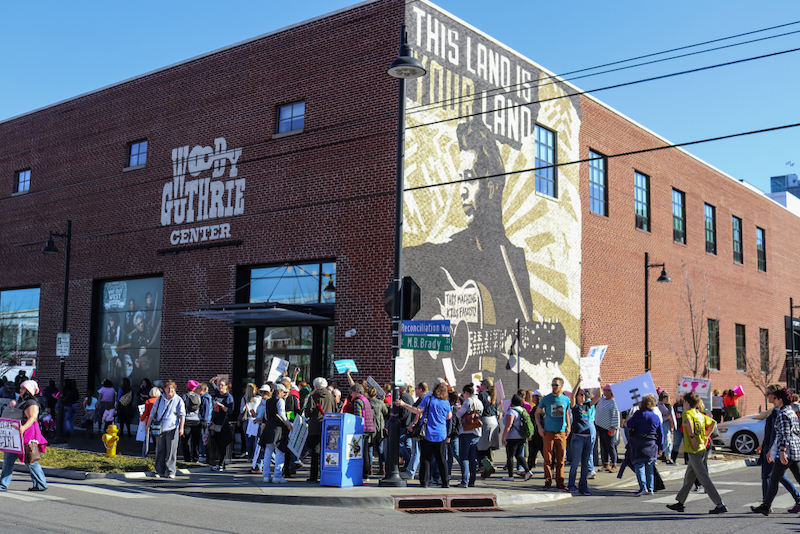Tulsa, Okla., doesn’t seem like an obvious location for the Bob Dylan Center, a museum for a Minnesota-raised artist and who first found fame in New York City’s 1960s folk scene. But, much like listening to Dylan’s music, the more time I spent at the wonderful new Dylan museum, the more I understood the reasoning behind it.
When Dylan made it known that he had kept a voluminous archive of more than 100,000 items that he was now willing to share with the world, the George Kaiser Family Foundation of Tulsa made a pitch. This foundation had taken on a similar trove belonging to Woody Guthrie, and opened a center in Tulsa in his name in 2013. After seeing the shrine to his former mentor, Dylan accepted the foundation’s offer to buy his collection. The two museums now occupy one large, redbrick building on the corner of MLK Boulevard and Reconciliation Way, in the heart of downtown Tulsa’s Arts District.

A mural of each artist adorns the wall outside their center’s entrances. Across the street, a park named Guthrie Green provides an inviting sense of space to the centers’ presence, as well as a band shell for regular free concerts.
The land on which we live and the history of ownership were foundational to Guthrie’s songwriting. The Woody Guthrie Center covers these issues carefully and displays examples of his writing, his whimsical artwork pieces and work from contemporary Native and Latin American artists questioning the idea of exactly who the “you” was that Guthrie sings of in his most famous song, “This Land Is Your Land.”
Guthrie covered a lot of that land, given to rambling from when he was a teenager. His eventual retreat from Oklahoma, along with countless other “Okies,” is vividly portrayed via a virtual reality simulation. Sitting down on the porch of a worker’s shack facade, I slipped on the headset and embedded earphones to see a wide, flat, 3D prairie before me. As a voiceover recounted the destruction of the Dust Bowl era, the wind howled and the sky darkened. Wildlife tried to escape a looming black wave on the horizon. Birds fell out of the air and eventually I was left in a quiet and eerie darkness.

It is a small museum, but one that covers Guthrie’s broad career and ongoing influence in popular music well. It was hard not to feel as if that influence might have been far deeper, too, had his work and life not been cut so short by Huntington’s disease, just as Dylan was crossing the country to seek him out in a Brooklyn hospital.
The Bob Dylan Center handles time in a more straightforward way. Upon arriving you are handed an iPod and studio-quality headphones, then directed to a large anteroom to watch a beautifully constructed short biographical film, made up largely of rare Dylan sit-down interviews and career-spanning clips. The images are broken up on the walls around you, falling apart and coming together again like various parts of a song.

It was the first part of an excellent immersive museum experience. Typically I forgo the audio guide option at museums, preferring to take in the exhibits without the distraction of more tech. But the iPods at the Bob Dylan Center are crucial to its enjoyment. Each display features a small disc. When you tap the iPod on the disc, the audio begins.
Clips include well-known songs, rare tracks, interviews and audio to complement various video displays. The overall effect is to be lost in the world of Dylan completely. You’ll get to pore over the tiny handwriting, the punctuation-free typewriter screeds of his lyrical drafts or related personal possessions while listening to a related song.
Dylan’s career timeline and different eras are charted along the walls of the gallery. In the middle of the gallery, six key songs from across different phases are carefully dissected, often from the inspiration and writing phase, through recording and all the way to live performances and alternate versions.
A small faux studio in one corner of the room also gives visitors the chance to remix popular Dylan songs at a simplified desk. Isolating the various tracks was a fun way to peer deeper into what made some of his most beloved productions so inventive.
Upstairs, past a small reading nook full of Dylan-related books, the temporary exhibit space offered “How Many Roads: Bob Dylan and His Changing Times 1961-1964,” a thorough exploration of perhaps Dylan’s most famous period as the young folk singer with a message, deeply embedded in the Civil Rights Movement.
Beside that, a long wall of glass cases displays 60 or more items of Dylan ephemera, including the tambourine that inspired “Mr. Tambourine Man,” tour merch, guitars, harmonica holders and a special nod to his Oklahoman guitar sideman Steve Ripley, each with accompanying on-screen details, video and audio. I left the museum partly out of exhaustion more than three hours in. But I could easily have stayed most of the day, if not for so much to see in and around town.




